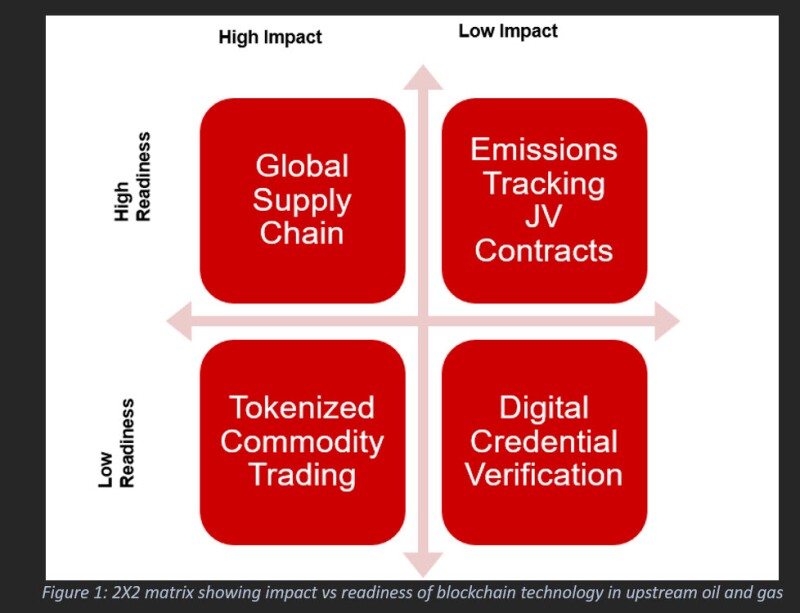The oil and gas sector is under relentless pressure to cut costs, boost sustainability, and streamline operations. This is an essential aspect to provide a reliable source of energy and necessitates the use of research and technology across domains. Blockchain—the decentralized digital ledger behind cryptocurrencies—is a transformative tool to address these challenges. For upstream operations, it can help in delivering trusted and secure data, faster transactions, and increased collaboration across complex data chains.
This article outlines blockchain fundamentals, its benefits for upstream oil and gas, and real-world initiatives from leading energy companies.
Blockchain, NFT, and Web3: 101
Libraries around the world are known to keep a detailed ledger of every book that has ever been added to the library, categorize it, and recorde every time the book has been checked out and returned. Because each book also has its own history of transactions, this enables transparency and decentralization of the data while the library acts as a single system enabling this diverse data access.
A blockchain system, very similar to a library, helps deliver decentralization, transparency, and automation. It is a distributed ledger that securely records transactions across a network of terminals/computers. Each record is time-stamped, linked to the previous one, and immutable. A single entity does not control the ledger, making it resistant to fraud and ideal for multiparty oil and gas projects.
Nonfungible tokens (NFTs) are unique digital certificates on a blockchain. They are useful in identifying the origin or attributes of a specific asset—for example, certifying a barrel of low-carbon crude or a carbon credit.
Web3 expands this network into a decentralized Internet, enabling peer-to-peer transactions without intermediaries. For energy companies, this propagates toward a future when trading, compliance, and emissions reporting happen on secure, open blockchain networks with smart contract automation.
Blockchain in Upstream Oil and Gas Industry
Oil and gas upstream operators must deal with complex challenges, often associated with data sensitivity, privacy, and access, including the following:
Opaque supply chains—As oil departs the wellhead, multiple transfers from one station to another can obscure the identification of the source, creating risks of fraud, theft, or noncompliance.
Complex joint ventures—Revenue splits, cost recovery, and capital approvals can take months via paper-based processes.
Siloed data—Several terabytes of operational data are often duplicated and inconsistent across partners.
Blockchain offers a shared, trusted source of truth for all stakeholders, reducing disputes and improving operational efficiency.
The prime benefits for implementing blockchain in upstream oil and gas include the following:
Transparency and traceability in industry—Every hold, transfer, quality check, or emissions reading can be hard logged. Regulators and buyers can verify the origin and compliance status of hydrocarbons, supporting ethical sourcing and sanctions compliance.
Faster joint venture collaboration—Smart contracts enabled through blockchain can automate and expedite processes such as authorizations for expenditure (AFEs) and revenue distribution. Partners shall have transparency in visualizing identical real-time data on production, costs, and entitlements, cutting disputes and audit times.
Data integrity and security—Blockchain ensures sensor data, maintenance logs, and certifications that cannot be tampered with. Governed or controlled ledgers allow sharing while maintaining confidentiality, empowering effective use of analytics and artificial intelligence. These processes and reporting also can be automated easily, minimizing errors.
Looking at a broader aspect of overall energy scenarios, certain high-impact applications of blockchain exist, such as the following:
Carbon emissions tracking—Blockchain creates a strong emissions ledger by recording methane or CO2 readings from field sensors. This enables
- Verifiable compliance with regulations
- Participation in carbon credit markets
- Transparent carbon-neutral certifications for exports
- Immutable records for carbon emission tracking
For example, industry associations are using blockchain to track methane emissions in real-time, helping operators reduce leaks and trade verified credits.
Regulatory compliance and supply chain security—As with the capture of production data, safety inspections can be automated along with instant reporting and transfer of custody. Such systems also can enforce control and transparency by verifying the origin of the crude.
For example, in 2018, ADNOC and IBM partnered to use blockchain to track every molecule of oil from well to end-customer, integrating upstream and downstream records for internal and external audits.
Smart contracts for operations and trading—With the capability to automatically include the data points in the blockchain system, contracts, payments, procurement, and service agreements can be automatically self-executed.
Blockchain Adoption in Action: Global Examples
North America: Blockchain for Energy
In 2019, ExxonMobil, Chevron, ConocoPhillips, Shell, and others formed the OOC Blockchain Consortium (now Blockchain for Energy) to standardize smart contracts and shared ledgers. Pilots include truck ticketing for shale operations and AFE balloting, cutting approval times from months to days.
Europe: VAKT and Origin Certification
Shell, BP, TotalEnergies, and Eni are using blockchain for commodity trading, renewable energy certificates, and fuel origin verification. Shell has also invested in blockchain startups for electricity and carbon tracking.
Barriers to Widespread Adoption
Regulatory clarity—Legal recognition of blockchain records and smart contracts vary by jurisdiction.
Scalability—Large-scale Internet of Things and trading use-cases require high throughput solutions.
Industry standards—Broad adoption needs common data formats, governance rules, and cross-company collaboration.
Despite these barriers, the momentum for blockchain adoption is rapidly pacing.

Blockchain is moving from pilot to production in oil and gas, with upstream operators using it for traceability, emissions tracking, and automated multiparty transactions. Technology’s real value lies in embedding trust and accountability into processes that span multiple stakeholders—a capability essential for the sector’s efficiency, compliance, and environmental, social, and governance commitments.
As pilot projects scale into shared platforms, smart contracts could manage transactions end-to-end, regulators could mandate blockchain-based reporting, and emissions data could be verified in real-time. For companies willing to collaborate and set standards today, blockchain offers a path to stronger governance, lower costs, and an operational model fit for the energy transition.
For Further Reading
Oil Giant Petrobras Explores BTC Mining, Tokenization by S. Kaaru, Coin Geek
How Blockchain is Transforming the Oil and Gas Industry by D. Singh, Debut Infotech.
Citi and ConsenSys Are Using Blockchain to Modernize Commodity Trading, ConsenSys
Blockchain Oil Trading Platform Backed by Shell and BP Is Now Live by Y. Khatri, CoinDesk
What is a Blockchain? Coinbase
US Oil, Gas Blockchain Consortium Launches with Chevron, ExxonMobil, Ledger Insights
Improving NNPC’s Supply Chain Through Blockchain Technology, Business Day

Ashish Fatnani is an industry solutions advisor for well construction at Halliburton, supporting customers across Europe, the Caspian, and Africa. With more than 12 years of global experience at Halliburton, Quest Global, and Mercedes-Benz, he partners with operators to drive digital transformation, optimize well construction, and unlock data-driven value through AI-enabled solutions. He holds a BS in petroleum engineering from Savitribai Phule Pune University, an MS from the University of Alaska Fairbanks, and an MBA from IIM Bangalore.
An SPE member since 2005, he has served on committees, contributed as a reviewer, and received the SPE Asia Pacific Regional Service Award in 2021.

Aman Srivastava is an adviser for TWA. He is product owner for Halliburton-Landmark. With a bachelor's degree in mechanical engineering from National Institute of Technology, Surat, India, a master's degree in petroleum engineering from the University of Oklahoma, and more than 15 years of experience in on-field and off-field drilling activities, Srivastava holds a special interest in well construction engineering and energy/sustainability. He received the SPE Mid-Continental Regional Award in 2023, is a reviewer of two peer-reviewed journals, and holds a patent for his design of an internal combustion engine. In his free time, he loves watching movies and reading books when he is not busy playing with his daughter and spending time with family.

